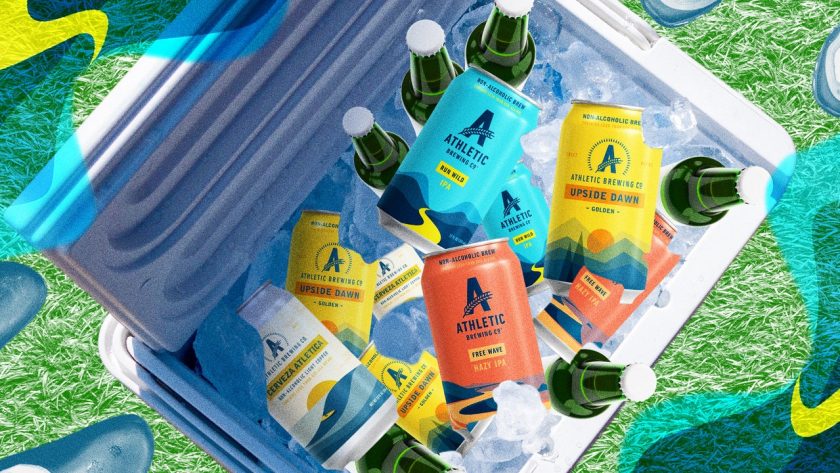Athletic entered my life on one of those stupid perfect early summer afternoons when very few things in the world sound better than sitting outside and having a beer. I was, as it so happens, on a friend’s stoop in Brooklyn. Another friend arrived with a couple six-packs of the nonalcoholic beer brand’s Hazy IPA. This friend, he loves to drink, but he figured I’d want to try it. Suspicious, I cracked one open.
Nonalcoholic beer—I know. I hadn’t touched a drink for over five years at that point, and even I turned my nose up at the stuff. For starters, I preferred wine or liquor before. Also: It was nonalcoholic beer.
But, lo! The Athletic tasted good. Undeniably good. Bitter and complex and full. Deliriously, pleasurably cold. The exact right amount of foamy. It tasted real. I drank about three more cans. (I realize the above scenario sounds like it was scripted by a wholesome, well-adjusted Don Draper.)
Athletic beer has since become ubiquitous: intermingling with regular beer cans at parties, sold at Whole Foods stores and corner delis, slapped on the beer menus at restaurants. A coworker arrived at a barbecue last month to find that “60% of the cooler was Athletic beer.” Unlike, say, seltzer, it was meant for savoring. It was meant for socializing. You could order a round with the drinkers, linger a while longer than you might have otherwise, and feel more at ease with not partaking.
Or you could still partake! There’s reportedly a popular beer and shot combo in Florida called “The Wild Buffalo”—a shot of bourbon, chased with an Athletic Run Wild IPA. At the Pencil Factory, a bar in Brooklyn, they have an unofficial joke special called “The Hypocrite.”
“Not too long ago, a customer was in the bar and ordered a tequila shot with an Athletic beer,” owner Brian Taylor told me with a chuckle. “And our manager said spontaneously, ‘We should call that The Hypocrite cocktail!’”
How, exactly, did Athletic Brewing Company turn one of the most unappealing, underwhelming, and frankly all-time depressing beverages into a booming $60 million a year business? How did it pocket a $50 million investment from Keurig Dr Pepper, land partnerships with Netflix and JetBlue, and sweep top prizes at beer contests around the globe? How did it build a loyal customer base, 80% of which drinks alcohol but still chooses to pay almost $15 for a six-pack for the nonalcoholic stuff?
Beyond that, how did it become an inescapable modern brand, one that has—can by can—changed the way we drink?
Drive two hours north of New York City, along the jammed-up commuter corridor. Tucked away in the small coastal city of Milford, Connecticut, you’ll find the world’s largest nonalcoholic brewery.
The first thing that hits you is the smell. Warm, fermenting beer permeates the cavernous 150,000-square-foot space—some of the 200,000 barrels of that will be produced annually here. Athletic moved into this place last summer, from its original, smaller location in a neighboring town. Stacks of empty cans line the walls from floor to sky-high ceiling. Each one is destined to be filled with beer, blasted in a tunnel pasteurizer, boxed up into 6 or 12 packs, then loaded onto pallets to make a journey to one of the 50,000 stores or 10,000 restaurants or bars where Athletic is sold. (Athletic also has a second brewery location in San Diego.)



